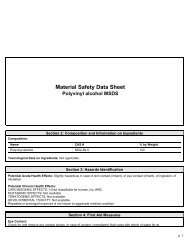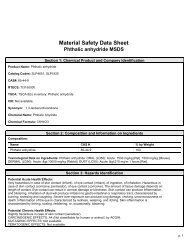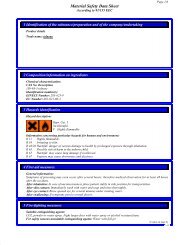acrylic acid_(msds).pdf - Jpdyechem.com
acrylic acid_(msds).pdf - Jpdyechem.com
acrylic acid_(msds).pdf - Jpdyechem.com
You also want an ePaper? Increase the reach of your titles
YUMPU automatically turns print PDFs into web optimized ePapers that Google loves.
Material Safety Data SheetAcrylic Acid MSDSComposition:Section 2: Composition and Information on IngredientsName CAS # % by WeightAcrylic Acid 79-10-7 100Toxicological Data on Ingredients: Acrylic Acid: ORAL (LD50): Acute: 33500 mg/kg [Rat]. 2400 mg/kg [Mouse]. DERMAL(LD50): Acute: 294 mg/kg [Rabbit]. VAPOR (LC50): Acute: 5300 mg/m 2 hours [Mouse]. 75 ppm 6 hours [Monkey].Section 3: Hazards IdentificationPotential Acute Health Effects:Very hazardous in case of skin contact (permeator), of eye contact (irritant, corrosive). Corrosive to skin andeyes on contact. Liquid or spray mist may produce tissue damage particularly on mucous membranes of eyes,mouth and respiratory tract. Skin contact may produce burns. Inhalation of the spray mist may produce severeirritation of respiratory tract, characterized by coughing, choking, or shortness of breath. Severe over-exposurecan result in death. Inflammation of the eye is characterized by redness, watering, and itching.Potential Chronic Health Effects:CARCINOGENIC EFFECTS: A4 (Not classifiable for human or animal.) by ACGIH, 3 (Not classifiable forhuman.) by IARC.MUTAGENIC EFFECTS: Classified POSSIBLE for human. Mutagenic for mammalian germ and somatic cells.TERATOGENIC EFFECTS: Classified SUSPECTED for human.DEVELOPMENTAL TOXICITY: Classified Reproductive system/toxin/male [POSSIBLE]. ClassifiedDevelopment toxin [SUSPECTED].p. 1
The substance is toxic to bladder, brain, upper respiratory tract, eyes, central nervous system (CNS).Repeated or prolonged exposure to the substance can produce target organs damage. Repeated or prolongedcontact with spray mist may produce chronic eye irritation and severe skin irritation. Repeated or prolongedexposure to spray mist may produce respiratory tract irritation leading to frequent attacks of bronchial infection.Repeated exposure to a highly toxic material may produce general deterioration of health by an accumulation inone or many human organs.Section 4: First Aid MeasuresEye Contact:Check for and remove any contact lenses. In case of contact, immediately flush eyes with plenty of water for atleast 15 minutes. Cold water may be used. Get medical attention immediately.Skin Contact:In case of contact, immediately flush skin with plenty of water for at least 15 minutes while removing contaminatedclothing and shoes. Cold water may be used.Wash clothing before reuse. Thoroughly clean shoes before reuse.Get medical attention immediately.Serious Skin Contact:Wash with a disinfectant soap and cover the contaminated skin with an anti-bacterial cream. Seek immediatemedical attention.Inhalation:If inhaled, remove to fresh air. If not breathing, give artificial respiration. If breathing is difficult, give oxygen. Getmedical attention immediately.Serious Inhalation:Evacuate the victim to a safe area as soon as possible. Loosen tight clothing such as a collar, tie, belt orwaistband. If breathing is difficult, administer oxygen. If the victim is not breathing, perform mouth-to-mouthresuscitation. WARNING: It may be hazardous to the person providing aid to give mouth-to-mouth resuscitationwhen the inhaled material is toxic, infectious or corrosive. Seek immediate medical attention.Ingestion:Do NOT induce vomiting unless directed to do so by medical personnel. Never give anything by mouth to anunconscious person. Loosen tight clothing such as a collar, tie, belt or waistband. Get medical attention ifsymptoms appear.Serious Ingestion: Not available.Flammability of the Product: Flammable.Auto-Ignition Temperature: 438°C (820.4°F)Flash Points: CLOSED CUP: 50°C (122°F).Flammable Limits: Not available.Section 5: Fire and Explosion DataProducts of Combustion: These products are carbon oxides (CO, CO2).Fire Hazards in Presence of Various Substances:Extremely flammable in presence of open flames and sparks.Highly flammable in presence of heat.Explosion Hazards in Presence of Various Substances:Risks of explosion of the product in presence of mechanical impact: Not available.Risks of explosion of the product in presence of static discharge: Not available.Fire Fighting Media and Instructions:p. 2
Flammable liquid, soluble or dispersed in water.SMALL FIRE: Use DRY chemical powder.LARGE FIRE: Use alcohol foam, water spray or fog. Cool containing vessels with water jet in order to preventpressure build-up, autoignition or explosion.Special Remarks on Fire Hazards: Not available.Special Remarks on Explosion Hazards: Not available.Section 6: Accidental Release MeasuresSmall Spill:Dilute with water and mop up, or absorb with an inert dry material and place in an appropriate waste disposalcontainer.Large Spill:Flammable liquid. Corrosive liquid. Poisonous liquid.Keep away from heat. Keep away from sources of ignition. Stop leak if without risk. Absorb with DRY earth,sand or other non-<strong>com</strong>bustible material. Do not get water inside container. Do not touch spilled material. Usewater spray curtain to divert vapor drift. Use water spray to reduce vapors. Prevent entry into sewers,basements or confined areas; dike if needed. Call for assistance on disposal. Be careful that the product is notpresent at a concentration level above TLV. Check TLV on the MSDS and with local authorities.Section 7: Handling and StoragePrecautions:Keep locked up.. Keep container dry. Keep away from heat. Keep away from sources of ignition. Ground allequipment containing material. Do not ingest. Do not breathe gas/fumes/ vapor/spray. Never add water to thisproduct. If ingested, seek medical advice immediately and show the container or the label. Avoid contact withskin and eyes. Keep away from in<strong>com</strong>patibles such as oxidizing agents, <strong>acid</strong>s, alkalis, moisture.Storage:Store in a segregated and approved area. Keep container in a cool, well-ventilated area. Keep container tightlyclosed and sealed until ready for use. Avoid all possible sources of ignition (spark or flame).Section 8: Exposure Controls/Personal ProtectionEngineering Controls:Provide exhaust ventilation or other engineering controls to keep the airborne concentrations of vapors below theirrespective threshold limit value. Ensure that eyewash stations and safety showers are proximal to thework-station location.Personal Protection:Face shield. Full suit. Vapor respirator. Be sure to use an approved/certified respirator or equivalent. Gloves.Boots.Personal Protection in Case of a Large Spill:Splash goggles. Full suit. Vapor respirator. Boots. Gloves. A self contained breathing apparatus should beused to avoid inhalation of the product. Suggested protective clothing might not be sufficient; consult a specialistBEFORE handling this product.Exposure Limits:TWA: 2 (ppm) from ACGIH (TLV) [United States] [1997]TWA: 2 [Australia]STEL: 20 (ppm) [United Kingdom (UK)]TWA: 10 (ppm) [United Kingdom (UK)]Consult local authorities for acceptable exposure limits.p. 3
Physical state and appearance: Liquid.Odor: Acrid (Strong.)Taste: Not available.Molecular Weight: 72.06 g/moleColor: Colorless.pH (1% soln/water): Not available.Boiling Point: 141°C (285.8°F)Melting Point: 14°C (57.2°F)Critical Temperature: 342°C (647.6°F)Specific Gravity: 1.05 (Water = 1)Vapor Pressure: 0.5 kPa (@ 20°C)Vapor Density: 2.5 (Air = 1)Volatility: Not available.Odor Threshold: 0.092 ppmSection 9: Physical and Chemical PropertiesWater/Oil Dist. Coeff.: The product is more soluble in oil; log(oil/water) = 0.4Ionicity (in Water): Not available.Dispersion Properties:Partially dispersed in methanol, diethyl ether.See solubility in water.Solubility:Soluble in cold water.Very slightly soluble in acetone.Insoluble in diethyl ether.Stability: The product is stable.Instability Temperature: Not available.Conditions of Instability: Not available.Section 10: Stability and Reactivity DataIn<strong>com</strong>patibility with various substances:Extremely reactive or in<strong>com</strong>patible with oxidizing agents, <strong>acid</strong>s, alkalis.Reactive with moisture.Corrosivity:Slightly corrosive in presence of steel, of aluminum, of zinc, of copper.Non-corrosive in presence of glass.Special Remarks on Reactivity: Not available.p. 4
Special Remarks on Corrosivity: Not available.Polymerization: Yes.Section 11: Toxicological InformationRoutes of Entry: Absorbed through skin. Dermal contact. Eye contact. Inhalation.Toxicity to Animals:WARNING: THE LC50 VALUES HEREUNDER ARE ESTIMATED ON THE BASIS OF A 4-HOUR EXPOSURE.Acute oral toxicity (LD50): 2400 mg/kg [Mouse].Acute dermal toxicity (LD50): 294 mg/kg [Rabbit].Acute toxicity of the vapor (LC50): 75 6 hours [Monkey].Chronic Effects on Humans:CARCINOGENIC EFFECTS: A4 (Not classifiable for human or animal.) by ACGIH, 3 (Not classifiable forhuman.) by IARC.MUTAGENIC EFFECTS: Classified POSSIBLE for human. Mutagenic for mammalian germ and somatic cells.TERATOGENIC EFFECTS: Classified SUSPECTED for human.DEVELOPMENTAL TOXICITY: Classified Reproductive system/toxin/male [POSSIBLE]. ClassifiedDevelopment toxin [SUSPECTED].Causes damage to the following organs: bladder, brain, upper respiratory tract, eyes, central nervous system(CNS).Other Toxic Effects on Humans:Very hazardous in case of skin contact (permeator), of eye contact (corrosive).Hazardous in case of skin contact (corrosive), of inhalation (lung corrosive).Special Remarks on Toxicity to Animals: Not available.Special Remarks on Chronic Effects on Humans: Not available.Special Remarks on other Toxic Effects on Humans: Not available.Section 12: Ecological InformationEcotoxicity:Ecotoxicity in water (LC50): 130 mg/l 24 hours [Trout]. 460 mg/l 96 hours [Trout]. 270 mg/l 24 hours [Waterflea].BOD5 and COD: Not available.Products of Biodegradation:Possibly hazardous short term degradation products are not likely. However, long term degradation products mayarise.Toxicity of the Products of Biodegradation: The products of degradation are less toxic than the product itself.Special Remarks on the Products of Biodegradation: Not available.Waste Disposal:Section 13: Disposal ConsiderationsDOT Classification: Class 8: Corrosive materialSection 14: Transport Informationp. 5
Identification: : Acrylic Acid, Inhibited UNNA: UN2218 PG: IISpecial Provisions for Transport: Not available.Section 15: Other Regulatory InformationFederal and State Regulations:Rhode Island RTK hazardous substances: Acrylic AcidPennsylvania RTK: Acrylic AcidFlorida: Acrylic AcidMinnesota: Acrylic AcidMassachusetts RTK: Acrylic AcidNew Jersey: Acrylic AcidTSCA 8(b) inventory: Acrylic AcidTSCA 5(e) substance consent order: Acrylic AcidTSCA 8(a) IUR: Acrylic AcidTSCA 12(b) annual export notification: Acrylic AcidSARA 313 toxic chemical notification and release reporting: Acrylic AcidCERCLA: Hazardous substances.: Acrylic Acid: 1 lbs. (0.4536 kg)Other Regulations: OSHA: Hazardous by definition of Hazard Communication Standard (29 CFR 1910.1200).Other Classifications:WHMIS (Canada):CLASS B-3: Combustible liquid with a flash point between 37.8°C (100°F) and 93.3°C(200°F).CLASS E: Corrosive liquid.DSCL (EEC):HMIS (U.S.A.):Health Hazard: 3Fire Hazard: 2Reactivity: 2Personal Protection:National Fire Protection Association (U.S.A.):Health: 3Flammability: 2Reactivity: 2Specific hazard:Protective Equipment:Gloves.Full suit.Vapor respirator. Be sure to use anapproved/certified respirator orequivalent. Wear appropriate respiratorwhen ventilation is inadequate.Face shield.p. 6














